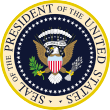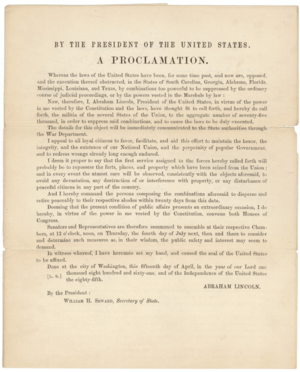Proclamation 80 facts for kids
| {{#property:P1476}} | |
 |
|

Proclamation 80
|
|
| Type | Presidential proclamation |
|---|---|
| Executive Order number | {{#property:P1555}} |
| Signed by | [[{{#property:P50}}]] on {{#property:P571}} |
| Federal Register details | |
| Publication date | {{#property:P577}} |
| Document citation | {{#property:P1031}} |
| Summary | |
| Responds to the Confederate attack on Fort Sumter, South Carolina by calling forth 75,000 militiamen. | |
Proclamation 80 was an important order given by President Abraham Lincoln on April 15, 1861. After the start of the U.S. Civil War, Lincoln used this proclamation to call for 75,000 volunteer soldiers, known as militia, to stop the rebellion of the southern states that had formed the Confederacy.
Contents
Why Was the Proclamation Needed?
In April 1861, the nation was in crisis. Several southern states had left the Union and formed their own government, the Confederacy. The conflict turned into a war when Confederate soldiers attacked Fort Sumter, a U.S. army post in South Carolina.
President Lincoln had to act quickly to deal with this rebellion, which he called an "insurrection." He believed it was his duty to keep the United States together. His first major step was issuing Proclamation 80 to build an army and restore order.
Around the same time, Lincoln also suspended habeas corpus. This is a legal rule that protects people from being held in jail without a good reason. The Chief Justice of the Supreme Court, Roger Taney, argued that only the Congress had the power to do this, not the president. To get official support for his actions, Lincoln called for a special meeting of Congress.
What Did the Proclamation Say?
The original text of the proclamation is long and uses formal language. In simple terms, here is what President Lincoln ordered:
- A Rebellion is Happening: Lincoln stated that in seven states (South Carolina, Georgia, Alabama, Florida, Mississippi, Louisiana, and Texas), groups of people were opposing U.S. laws. He said these groups were too powerful for regular law enforcement to handle.
- Calling for Soldiers: Using his power as president, Lincoln called for 75,000 men from the state militias to join together and form an army to "suppress said combinations" (stop the rebellion).
- A Call for Support: He asked all loyal American citizens to help and support this effort to protect the nation.
- A Warning to Rebels: The proclamation commanded the rebels to stop fighting and return to their homes peacefully within 20 days.
- Meeting with Congress: Lincoln called for the U.S. Congress to meet on July 4, 1861, to discuss the crisis and decide on what to do next.
Did Lincoln Have the Power to Do This?
President Lincoln did not just invent this power. He was using a law that had been passed many years earlier called the Militia Act of 1795.
The Militia Act of 1795
This old law gave the president specific powers in a crisis. It said that if a rebellion was too strong for the courts or police to handle, the president could:
- Call up the militias (volunteer soldiers from different states) to enforce the law.
- Command the rebels to go home peacefully.
Lincoln followed this law carefully. By first ordering the rebels to go home in Proclamation 80, he made it legal for him to then use the militia to stop them when they refused.
Limits on the President's Power
The Militia Act had some important limits.
- Time Limit: Soldiers called up under this act could only be required to serve for three months in a single year.
- Number of Soldiers: An even older law from 1799 limited the number of militia the president could call to 75,000 men. This number was set when the U.S. population was much smaller and had never been updated.
Because of these limits, Lincoln knew this first group of soldiers was only a temporary solution to the growing crisis.
Putting the Plan into Action
Immediately after the proclamation, the government sent out a "Call to Arms" to the governors of the states that were still in the Union. The message asked each governor to supply a certain number of soldiers, called a "quota."
Here is how the call for 75,000 volunteers was divided:
- 17 regiments: New York
- 15 regiments: Pennsylvania
- 13 regiments: Ohio
- 6 regiments each: Illinois and Indiana
- 4 regiments each: New Jersey, Maryland, Kentucky, and Missouri
- 3 regiments: Virginia
- 2 regiments each: Massachusetts, North Carolina, and Tennessee
- 1 regiment each: Maine, New Hampshire, Vermont, Rhode Island, Connecticut, Delaware, Arkansas, Michigan, Wisconsin, Iowa, and Minnesota
Each regiment was made up of about 780 men. The total number of soldiers requested from the states was 73,910. The rest of the 75,000 men were to come from troops in the District of Columbia.
Not all states were willing to send troops. The governors of the border states like Kentucky, Missouri, North Carolina, and Tennessee, which had not yet left the Union, refused Lincoln's request. Their refusal showed just how deeply the country was divided.

